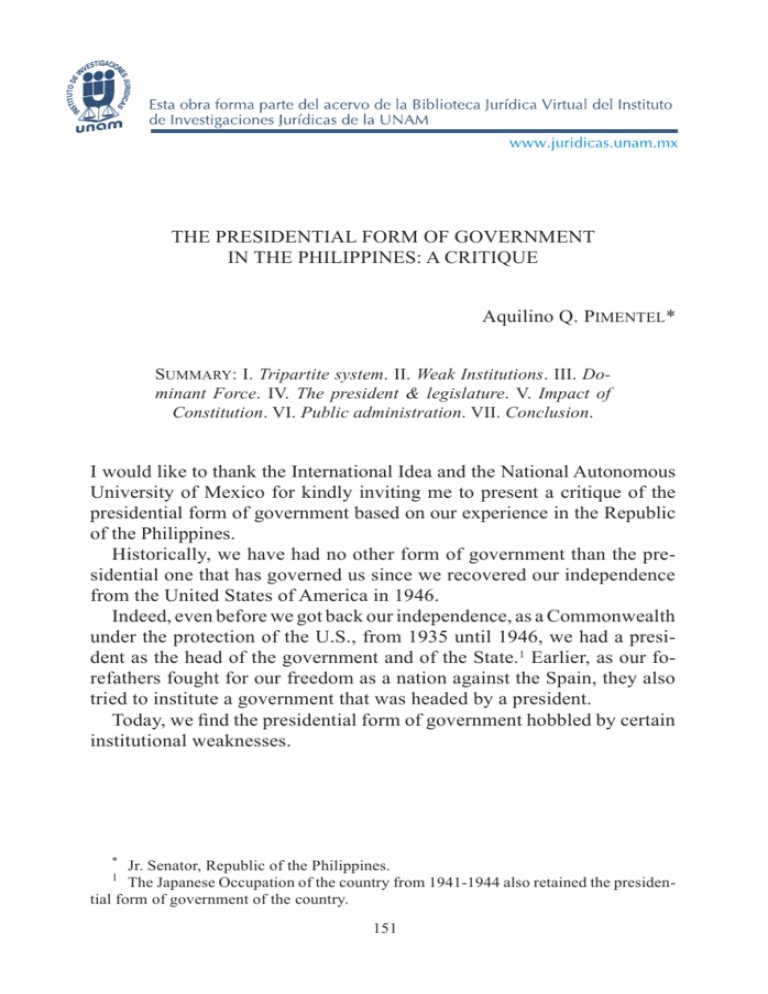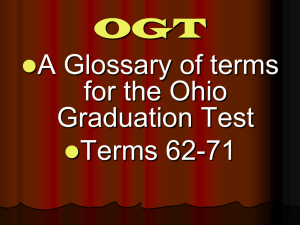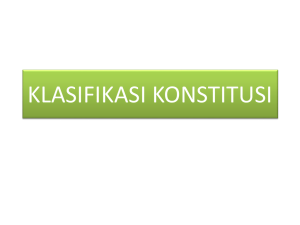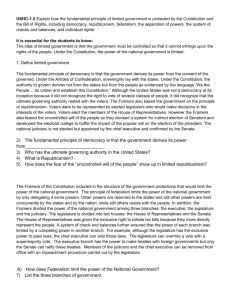THE PRESIDENTIAL FORM OF GOVERNMENT IN THE
advertisement

THE PRESIDENTIAL FORM OF GOVERNMENT IN THE PHILIPPINES: A CRITIQUE Aquilino Q. Pimentel* Summary: I. Tripartite system. II. Weak Institutions. III. Dominant Force. IV. The president & legislature. V. Impact of Constitution. VI. Public administration. VII. Conclusion. I would like to thank the International Idea and the National Autonomous University of Mexico for kindly inviting me to present a critique of the presidential form of government based on our experience in the Republic of the Philippines. Historically, we have had no other form of government than the presidential one that has governed us since we recovered our independence from the United States of America in 1946. Indeed, even before we got back our independence, as a Commonwealth under the protection of the U.S., from 1935 until 1946, we had a president as the head of the government and of the State.1 Earlier, as our forefathers fought for our freedom as a nation against the Spain, they also tried to institute a government that was headed by a president. Today, we find the presidential form of government hobbled by certain institutional weaknesses. * Jr. Senator, Republic of the Philippines. The Japanese Occupation of the country from 1941-1944 also retained the presidential form of government of the country. 1 151 152 Aquilino Q. Pimentel I. Tripartite system Our Constitution mandates that we follow a tripartite system of governance where the powers of government are distributed among three major branches, namely, the Executive Department headed by the President; the Legislative Department which has two houses, the House of Representatives and the Senate, and the Judiciary on top of which is the Supreme Court. The three branches are supposed to be co-equal. And they are supposed to check one another so that official abuses are curbed and the rights and liberties of the people are protected. II. Weak Institutions In our experience, however, weak political parties, weak judicial structures and weak legislatures have all contributed to the emerging phenomenon of an imperial presidency. This characterization of the presidency as an imperial one simply means that in the context of the political structure now obtaining in our country, the president tends to overwhelm the other two co-equal branches, the legislature and the judiciary. The weak political parties fail to act as a sieve against the surfacing of mediocre personalities contending for the presidency. Instead of insuring that only the best and the brightest should have the opportunity to serve as the president of the nation, they cater to the passions of the day and abet the election of the person who can best deliver patronage benefits to them. The weak parties also produce weak members of the legislature who tend to gratify the base wishes of their constituents rather than work for the good of the nation. III. Dominant Force Negatively, the cumulative effect of the weaknesses adverted to makes the president not only primus inter pares among the supposedly co-equal branches of government but the dominant force in the entire political spectrum of the country. THE PRESIDENTIAL IN THE PHILIPPINES 153 And positively, the constitutional power of appointment the president has over the major functionaries of government from the cabinet ministers or secretaries as we call them back home to the ambassadors, to the officials of constitutional bodies like the Ombudsman and the Commission on Human Rights, to military officers from the rank of colonel to the top police officers to the regional directors running government offices and to the directors of government-owned corporations makes him or her a superpower in the political firmament of the nation. In a word, the president has lots of favors to hand out to whoever is willing to bow down to his or her wishes. Under present circumstances, and in a developing country like ours, sad to say, wheeling and dealing for personal advantage tend to become the norm to land a government position rather than the exception. Since it is the president, for example, who appoints all members of the Judiciary from the lowest trial court to the Supreme Court, it is not surprising that sometimes the exercise of judicial power gets tainted by political pressure. On paper, the legislature is vested with the power to check presidential appointments but because of the weaknesses earlier adverted to by and large the president gets to appoint his or her personal supporters to choice positions in the political arm of the government or even to judicial seats. IV. The president & legislature In trying to explain the dynamics of the push and pull of power between the president and the legislature, we have to clarify that the Republic of the Philippines is a multiparty democracy under a presidential form of government. Because the president is the dominant force in the nation’s political spectrum, he or she determines which bloc or coalition of blocs becomes the majority party in the legislature. Whoever is president, in fact, becomes a magnet that draws lawmakers from whatever party to his or her political party or coalition which thus becomes the majority or the ruling party. The fact that the president has the power to create the majority in the legislature is bolstered mainly by his or her power over the purse. This 154 Aquilino Q. Pimentel is true even if under our Constitution, it is the legislature that enacts a national budget. The moneys, thus, appropriated may, however, only be disbursed by authority of the president. In our case now as opposition members of the Senate, we find the releases of funds for projects that we recommend difficult to come by. It was not so before the present administration. V. Impact of Constitution To repeat, the Constitution is supposed to limit the powers of the presidency in the same way that it is expected to regulate the legislature. But because of the flaws or weaknesses of our institutions, the president has emerged as the more dominant of the two. 1. Example To cite one example: in the past year alone, there had been several attempts to impeach the president. To no avail. The incumbent was able to subvert the impeachment process by the use of funds and pressure on weak-kneed and gullible members of the House. 2. Another example Then, there is a constitutional provision that is being manipulated by the President to suit her ends. The President is the Commander-in-Chief of all armed forces of our country and whenever it becomes necessary, he or she may call out the armed forces to prevent or suppress lawless violence, invasion or rebellion. In the recent past, the president had called out the armed forces to the capital city of Manila ostensibly to suppress lawless violence, invasion or rebellion even if actually non-existent. And when concerned citizens contest such calls, the judiciary felt reluctant to censure her move especially when at the time the decision was forthcoming, the soldiers were made to return to the barracks. THE PRESIDENTIAL IN THE PHILIPPINES 155 VI. Public administration The President has full powers to restructure the executive department that under the Constitution is under her “control and supervision”. In general that means that she may reassign or reduce the personnel of the various cabinet departments and realign their budgets. The incumbent has even tinkered with the legal functions of certain offices attached to certain departments by transferring them to other offices. As a result, public administration in the Republic is prejudiced by the political maneuverings of the President and her allies. Bureaucratic professionalism suffers. And public administration, less effective. In my view, public administration deals mainly with the delivery of basic services to the people. By its very nature and considering the vastness of our archipelagic country, public administration to be effective must not be concentrated in the hands of one person or office centrally located in Manila but devolved to the regions. The tendency, however, in the country today is for the delivery especially of major services to be done only upon orders of the President and her underlings in the cabinet who hold office in Manila. Thus, we see much dissatisfaction all over the nation. Poll surveys in the last year alone show that the President’s satisfaction rating has constantly fallen.2 VII. Conclusion I suppose that the problems we face in the country today are not merely due to the presidential form of government. It has also to do with the 2 In 2006, her ratings according to were 34% Satisfied and 47% Dissatisfied with the performance of President Gloria Macapagal-Arroyo, for a Net Satisfaction score of -13 (% Satisfied minus % Dissatisfied), according to the final 2006 Social Weather Survey, fielded over November 24-29. In 2007, the new Social Weather Survey of November 30 - December 3, 2007 found 32% satisfied and 48% dissatisfied with President Gloria Macapagal-Arroyo’s performance, for a Net Satisfaction rating of -16 (% satisfied minus % dissatisfied). This compares with 34% satisfied and 45% dissatisfied with her, or net -11, as of September 2007. 156 Aquilino Q. Pimentel kind of people that we elect to be our leaders. Somebody has said that a people deserve the government they elect. Nonetheless, because we have an archipelagic country, because we have various ethnic peoples, because we have a huge Christian population and relatively large Muslim communities, because we have diverse languages, and because the presidential form of government does not appear workable in our country, there is an outcry to try the other viable system of government that some countries find workable. That is the federal system of government. There is a lot of obstacles to overcome, objections to address, and questions to answer regarding the viability of the federal system. But, unless the presidential type of government that we have in the country would adequately respond to the needs of the people and in the immediate future, I guess its days are numbered.









